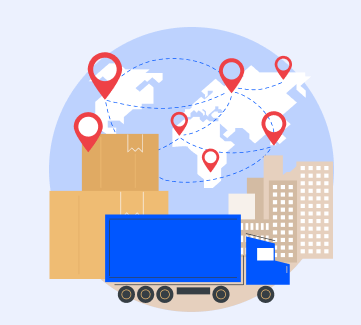In recent years, the global shipping industry has set sail towards a new horizon – one where sustainability is the guiding star. Carbon neutral shipping has emerged as a beacon of hope, promising to revolutionize the way goods are transported across the seas. This transformative concept seeks to balance the scales of environmental impact, making the delivery of goods not just a logistical triumph but an eco-friendly voyage into the future.
What is Carbon-neutral Shipping?
Carbon neutral shipping is a groundbreaking approach to maritime transportation, placing environmental sustainability at its core. By minimizing and offsetting carbon emissions associated with shipping, this transformative concept aims to chart a course towards a greener future. Leveraging alternative fuels, innovative technologies, and strategic investments in carbon offset projects, industry leaders, exemplified by pioneers like Maersk, are steering towards carbon neutrality. This commitment extends to the last mile, where carbon neutral delivery practices, especially in e-commerce hubs like Europe, and the integration of eco-conscious strategies by platforms like Shopify and Ebay, are reshaping the landscape. This paradigm shift isn’t just a trend but a fundamental transformation, making carbon neutral shipping the wind in the sails propelling the industry towards a legacy of responsible and sustainable practices.
The term “carbon neutral shipping meaning” refers to the practice of offsetting or minimizing the carbon emissions associated with transporting goods, emphasizing environmental responsibility in the shipping industry.
Setting Sail into Sustainability
Carbon neutral shipping, a term that has gained prominence in environmental discussions, refers to the process of mitigating and offsetting the carbon emissions generated during the transportation of goods. This approach marks a significant departure from the traditional practices that have long cast a shadow of environmental concern over the shipping industry. By opting for carbon neutral shipping, companies commit to a journey where the carbon footprint of transporting goods is minimized and, when unavoidable emissions occur, offset through sustainable initiatives.
Decoding Carbon Neutral Shipping
To unravel the intricacies of carbon neutral shipping, it’s crucial to understand its fundamental principles. The term “carbon neutral shipping” encompasses a broad spectrum of eco-friendly practices, ranging from the use of alternative fuels to innovative technologies that reduce emissions. It’s not merely about reaching the destination; it’s about navigating the route with the least possible impact on the environment
The Maersk Odyssey: Pioneering Carbon Neutral Shipping
One of the trailblazers in the realm of carbon neutral shipping is Maersk, a global shipping giant. Maersk has set ambitious targets to achieve carbon neutrality across its entire fleet by 2050. This commitment is a testament to the industry’s collective realization that neutral shipping isn’t just a concept; it’s a responsibility.
The Challenge of Carbon Offset Shipping
Carbon offset shipping is a critical aspect of the carbon neutral equation. It involves investing in projects that remove or reduce emissions equivalent to those produced during shipping. This proactive measure acts as a counterbalance, tipping the scales towards a more sustainable and environmentally friendly future. The challenge lies in identifying and implementing offset projects that are not only effective but also aligned with the broader goals of carbon neutrality.
Understanding Climate Neutral Shipping
While the terms “carbon neutral shipping” and “climate neutral shipping” are often used interchangeably, it’s essential to grasp their subtle distinctions. Carbon neutral shipping primarily focuses on offsetting carbon emissions, whereas climate neutral shipping adopts a more holistic approach, considering a broader range of greenhouse gases. The goal is to create a balance between emissions and actions that contribute to the overall well-being of the climate.

Carbon Neutral Delivery: Beyond the Last Mile
The commitment to sustainability extends beyond the high seas to the last mile. Carbon neutral delivery, also known as co2 neutral delivery, ensures that the environmental impact of the entire shipping process is minimized. This includes not only the transportation on sea but also the final mile delivery to the end consumer.
The Final Mile Dilemma: Navigating Challenges
Final mile delivery, the last leg of the shipping journey, poses unique challenges in achieving carbon neutrality. Often characterized by short distances but frequent stops, it demands innovative solutions to reduce emissions. At the core of this puzzle, fulfillment centers serve as vital hubs, where products are stored, processed, and readied for the final leg of their journey.
Fulfillment Centers: The Unsung Heroes of Carbon Neutral Shipping
Fulfillment centers, strategically located in Europe and other key regions, act as the nerve centers of the carbon offset shipping process. These centers play a crucial role in optimizing logistics, streamlining processes, and reducing the overall carbon footprint. Leveraging advanced fulfillment software ensures efficiency and sustainability, turning these centers into silent champions of carbon neutral shipping.
E-commerce Giants and Carbon Neutral Shipping
In the realm of e-commerce, where platforms like Shopify, Ebay, and Bigcommerce reign supreme, the focus on carbon neutral shipping is gaining momentum. E-commerce fulfillment services are increasingly integrating carbon neutral practices into their operations, aligning with the growing consumer demand for sustainable practices.
The Green Frontier: Supplement and Cosmetics Fulfillment
In the world of Cosmetics Fulfillment, precision and care in shipping are paramount, as companies strive to deliver beauty products seamlessly and sustainably to customers worldwide. Industries like supplement and cosmetics fulfillment are not exempt from the green revolution. As consumer awareness about the environmental impact of products grows, companies in these sectors are recognizing the need to adopt carbon neutral shipping practices. This shift is not just a response to market trends; it’s a strategic move towards long-term sustainability. Specializing in Supplement Fulfillment, companies in this industry are prioritizing efficient and sustainable shipping practices, ensuring timely delivery of health and wellness products to consumers.
Carbon Neutral Shipping: Defining the Landscape
In the landscape of carbon neutral shipping, clarity on terminology is essential. A carbon neutral courier, for instance, refers to a carbon neutral delivery service committed to offsetting its carbon emissions, ensuring a net-zero impact on the environment. Similarly, carbon neutral parcel delivery signifies a focus on reducing and offsetting emissions associated with individual packages.
The Journey Ahead: Charting a Course for Sustainable Shipping
As we navigate the seas of change, it is evident that carbon neutral shipping is not a fleeting trend but a fundamental shift in the industry’s ethos. The combined efforts of shipping giants like Maersk, innovative fulfillment centers, and e-commerce platforms are steering the industry towards a more sustainable future.
How to Reduce Carbon Emissions From Shipping?
Carbon-neutral shipping, a transformative endeavor for the maritime industry, involves a multifaceted strategy. Here’s a list of key elements that collectively usher in a new era of sustainability:
1) Alternative Fuels
Transitioning from traditional fuels to eco-friendly alternatives stands out as a pivotal step in the pursuit of reduced carbon emissions during shipping. Embracing alternative fuels that are environmentally conscious and economically viable is crucial for achieving carbon neutrality.
2) Advanced Fulfillment Software
Implementing state-of-the-art software within strategically located fulfillment centers is another critical element. This technology optimizes logistics, streamlines operations, and minimizes the environmental impact of shipping processes. Advanced fulfillment software is a necessity, ensuring efficiency in the quest for eco-friendly shipping practices. Fulfillment centers in Europe play a strategic role in optimizing shipping logistics and reducing the carbon footprint of the supply chain.
3) Carbon Offset Projects
Constituting a cornerstone in achieving carbon neutrality, investing in projects that remove or reduce emissions equivalent to those generated during shipping actively contributes to counterbalancing the environmental impact. Proactive measures in carbon offset projects align with the industry’s commitment to creating a harmonious balance between shipping activities and ecological well-being.
4) E-commerce Platforms
Leading e-commerce platforms like Shopify, Ebay, and Bigcommerce play a pivotal role in shaping the future of shipping. By integrating sustainable practices into their fulfillment services, these platforms set the tone for a greener shipping landscape. As industry influencers, they emphasize the importance of eco-friendly practices at every stage of the supply chain.
Conclusion
As the industry strives for carbon neutrality, each of these elements plays a vital role in steering the course towards a greener future. This holistic approach reflects a commitment to not only meeting logistical demands but also to safeguarding the planet for future generations.
The choice of packaging materials becomes instrumental in achieving carbon neutrality. Eco-friendly packaging options, such as those made from recycled and recyclable materials, contribute to minimizing waste and fostering sustainable practices. Collaboration with eco-friendly packaging companies like noissue and Packlane further enhances the integration of environmentally-conscious practices into the shipping process. Shopify Fulfillment, Ebay Fulfillment, and Bigcommerce Fulfillment services collectively contribute to efficient and environmentally conscious shipping practices, enhancing the overall fulfillment experience for online retailers across various platforms.
In conclusion, the era of carbon neutral shipping signifies a paradigm shift, where environmental responsibility is intertwined with logistical efficiency. As the industry charts a course towards a sustainable future, the focus on carbon neutral shipping is not just a necessity; it’s a commitment to leaving behind a legacy of responsible and eco-conscious practices.




 Community
Community
